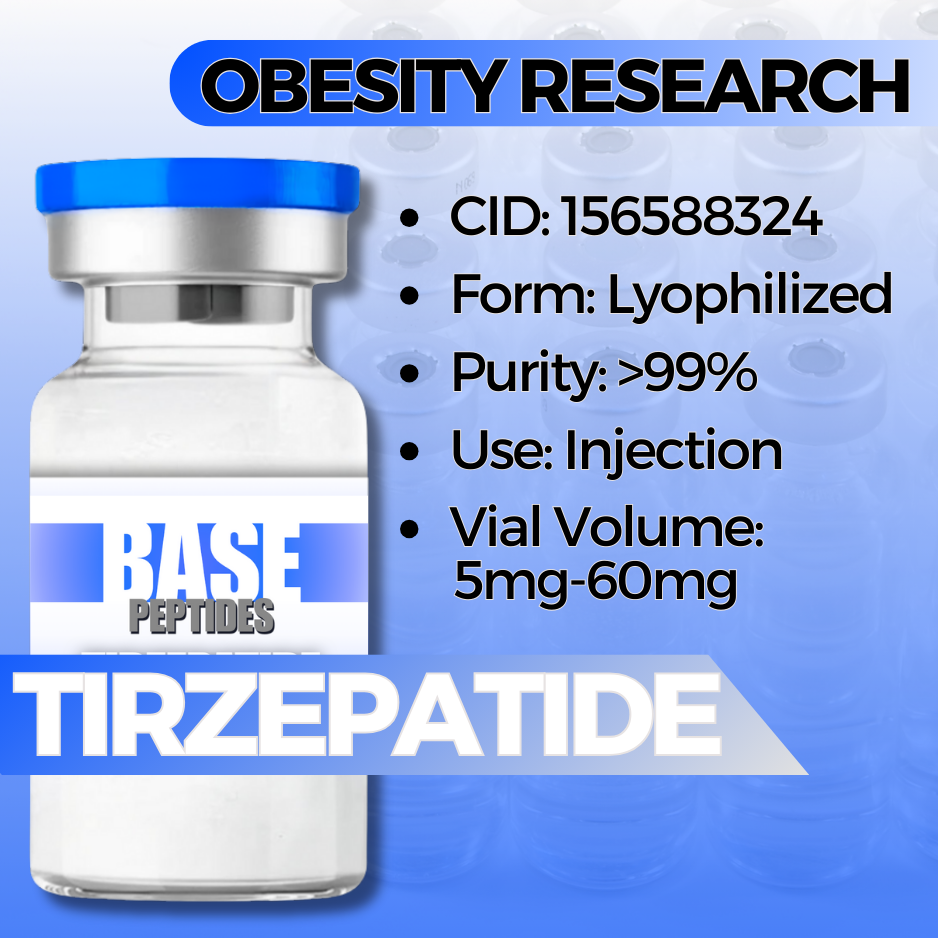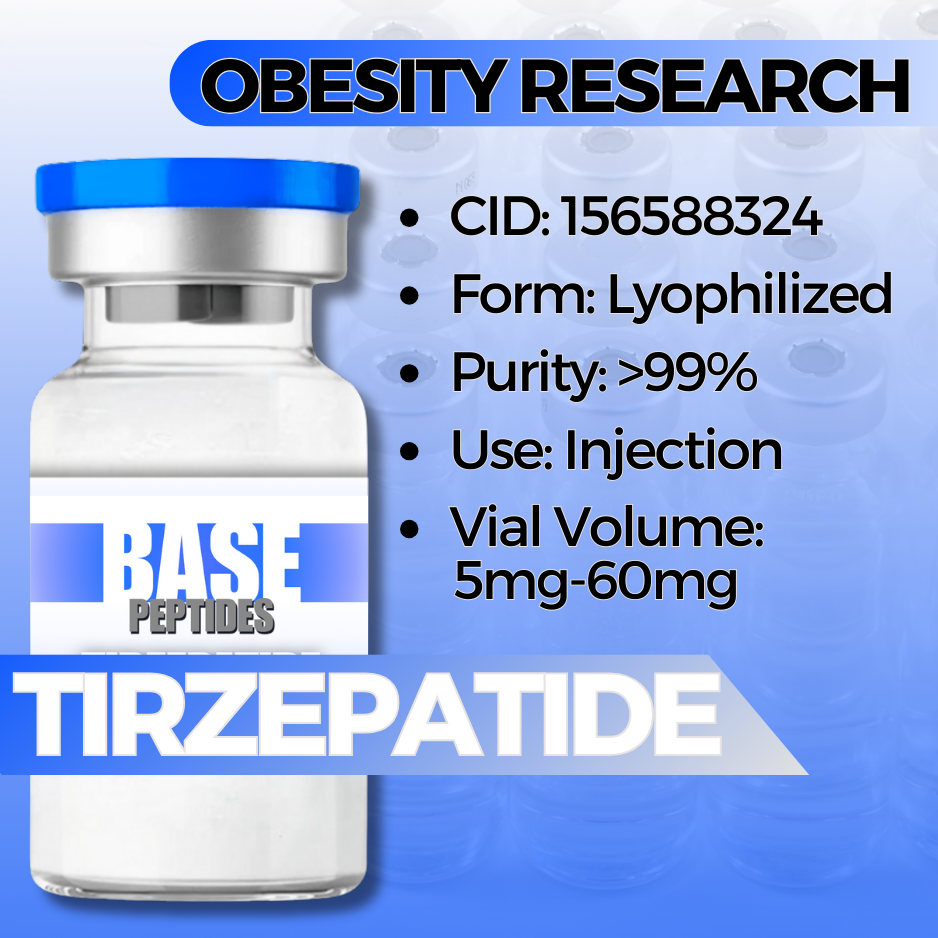TIRZ
TIRZ
Base Peptides are intended for licensed medical professionals and experienced researchers. Reconstitution required. Dosing and use instructions are not provided.
Couldn't load pickup availability
Tirzepatide — Dual Incretin (GLP-1 + GIP) Receptor Agonist
Tirzepatide is a long-acting peptide that activates both the GLP-1 and GIP receptors. In research, it’s used to study how dual-incretin signaling influences glucose control, appetite pathways, and body-composition trends beyond what single-pathway GLP-1 analogues show.
- CAS: 2023788-19-2
- Peptide class: Long-acting incretin analogue (dual GLP-1/GIP)
- Approx. MW: ~4.8 kDa (sequence/salt form dependent)
- Design: Modified incretin sequence with a fatty-diacid side chain for albumin binding (extended half-life)
- GLP-1 receptor: supports insulin release, slows gastric emptying, and promotes a natural sense of fullness.
- GIP receptor: complements GLP-1 by modulating insulin secretion and adipose signaling in a context-dependent way.
- Together: Dual activation lets researchers observe broader metabolic effects than with GLP-1 alone, including changes in energy intake and fat distribution.
- To compare dual-pathway vs single-pathway incretin signaling.
- To examine glucose tolerance, appetite regulation, and lipid markers.
- To explore body-composition shifts (including visceral fat) over longer time frames.
Key Studies — What Was Tested, What Changed, Why It Matters
Glucose control and insulin dynamics
- What was tested: Time-course effects on fasting and post-meal glucose, insulin secretion, and insulin sensitivity.
- What changed: Smoother glucose curves and stronger post-meal insulin responses vs baseline models; fewer high spikes after feeding.
- Why it matters: Shows how dual-incretin signaling can reduce metabolic “turbulence,” a useful setup for pancreatic-cell and whole-body glucose-handling studies.
Appetite, gastric emptying, and energy intake
- What was tested: Central/peripheral signaling related to satiety, meal size, and gastric emptying rate.
- What changed: Reduced caloric intake, slower gastric emptying, and activation of appetite-regulating centers (brainstem/hypothalamus) in line with incretin biology.
- Why it matters: Offers a clear model for the brain–gut axis and how it shapes eating behavior and energy balance.
Body-composition and lipid profiles
- What was tested: Changes in fat/lean mass and circulating lipids during sustained dual-incretin exposure.
- What changed: Trends toward visceral fat reduction, improved triglycerides, and healthier lipid fractions over time.
- Why it matters: Helps parse how incretin signaling affects where fat is stored—not just how much—an important distinction in metabolic risk models.
Potential Research Applications
Metabolic Function
- Glucose tolerance, insulin-secretion assays
- β-cell function and incretin cross-talk
Appetite & Satiety
- Neuroendocrine signaling and meal-size control
- Gastric-emptying kinetics and gut–brain pathways
Body-Composition Research
- Visceral vs subcutaneous adiposity (CT/MRI/DEXA)
- Lipid panels and metabolic flexibility
Synergistic Peptides (for Study Design)
Semaglutide (GLP-1)
- Why pair/compare: Establishes the added value of dual vs single incretin signaling.
- Angle: Side-by-side insulin, appetite, and imaging endpoints.
AOD-9604
- Why pair: Used in fat-metabolism research; complements incretin pathways from a different mechanism.
- Angle: Adipose and mitochondrial markers under combined stimuli.
CJC-1295 (with DAC)
- Why pair: Probes cross-talk between GH/IGF-1 and incretin axes.
- Angle: Long-duration metabolic studies tracking glucose + lipid panels.
Design Notes
- Define arms clearly: GLP-1 only, dual incretin, and combo with endocrine tools.
- Control for feeding schedule, stress, and activity—these shift outcomes.
- Document formulation (pH, light exposure) and storage rigorously.
Known Concerns (Context)
- GI tolerance: Nausea and slower gastric emptying are common observations in incretin research; titration and timing matter.
- Model sensitivity: Appetite and glucose results can swing with environment; standardize meals, time of day, and stressors.
- General: Research use only; not for human consumption or therapeutic use.
Follow institutional SOPs for incretin-pathway peptides and metabolic sampling schedules.
Specifications & Handling
- Form: Lyophilized powder (lot-coded)
- Purity: ≥ 99% (HPLC/MS verified)
- Storage: ≤ −20 °C; protect from light/moisture
- In solution: Aliquot promptly; avoid repeat freeze–thaw
- Additives: None unless specified per lot
- Packaging: Tamper-evident; research-only labeling
Regulatory & Use Notice
Sold for laboratory research use only. Not for human consumption, medical, or veterinary use. No human-use instructions are provided. Buyer is responsible for safe handling and regulatory compliance.
Tirzepatide Peptide Research | Dual Incretin (GLP-1 + GIP) Agonist | Metabolic & Appetite Studies




